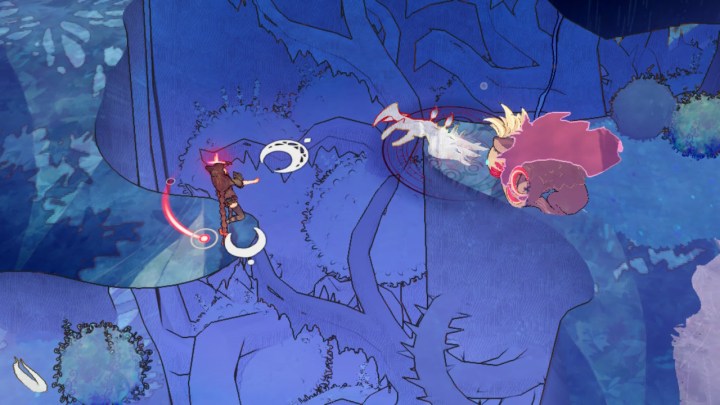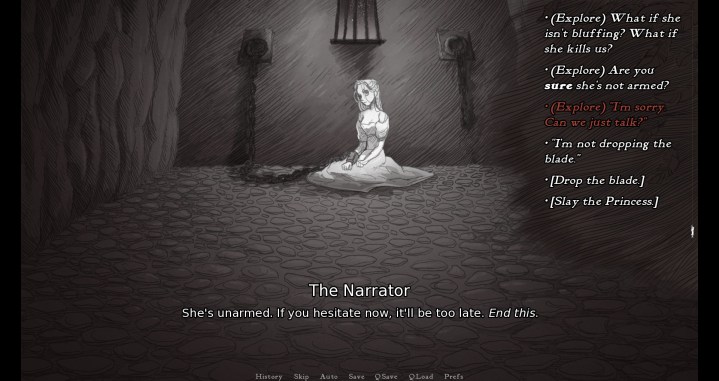
Most years, I struggle to put together a list of my top 10 favorite games. This year, I could write a top 20 without trying and I’d still have to leave things out.
2023 might’ve had the single most stacked release schedule in the history of this medium. Every month was a carnival of mainstream hits, sleeper indies, genre revivals, and old favorites releasing new content packs. No one’s had time to breathe since January unless they were caught up in one of this year’s waves of industry layoffs. (For as much fun as you’ve had this year, remember: the developers have had it rough.)
As usual, that means there’s also a bumper crop of great games that got lost in the shuffle. They came out at the wrong time, didn’t get the marketing they needed, or simply didn’t find their audience due to the crush. Here are some of the best games of this year that, for one reason or another, are getting overlooked.
Bayonetta Origins: Cereza and the Lost Demon

I’d forgotten that this came out this year until my editor brought it up, which says more about 2023 than the game itself. If Cereza and the Lost Demon reminds me of anything, it’s PlatinumGames’ previous title, Astral Chain, which features a similar pet-character gimmick. You independently control Cereza, a teenager who’s still learning witchcraft’s ropes, and her demonic pal Cheshire, who’s stuck inhabiting an old stuffed animal. Cheshire does the fighting, while Cereza handles puzzle-solving and environmental gimmicks.
The whole thing plays out like a dark children’s fable, complete with turning pages and a watercolor palette. I would’ve expected this to catch on with the Switch’s audience, but I have to assume that it got overshadowed by the hype for Tears of the Kingdom. It’s a fairly radical departure from the rest of the Bayonetta series, but Origins is an interesting long look into the witch’s complicated world.
Fae Farm

The problem with any attempt to break into the “cozy game” hustle is that most of these games don’t really have jumping-off points. Animal Crossing or Stardew Valley only end when your real life manages to seize the wheel from your life simulator. That can present an obstacle for any new game that’s trying to build an audience. For its first few hours, Fae Farm doubles down on that bedrock issue by simply being a relentlessly cheerful farming game. It only sets itself apart once you get a couple of hours into its main quest, which involves a long dungeon crawl and a lot of crafting.
At that point, the “Fae” part of its name kicks in, and it turns into an interdimensional faerie adventure. Now, you can explore another world, craft much weirder goods, and use a pair of customized faerie wings that let you jump around like Michael Jordan in low gravity. At that point, Fae Farm is cheerfully weird enough to give an unqualified recommendation, especially for anyone who’s running out of stuff to do in their current cozy retreat.
Fatal Frame: Mask of the Lunar Eclipse

Little-known fact: Fatal Frame traditionally didn’t sell well. It’s popular with fans and critics but has always had trouble building an audience, which makes it a surprise that Koei Tecmo has stuck with it for this long. Fortunately, the 2021 port of Maiden of Black Water did well enough that K-T finally released its predecessor in the West. Mask of the Lunar Eclipse, co-directed by Suda51, used to be a Japanese exclusive for the Wii, and is a sort of soft reboot for the series. Three teenage girls and the detective who saved their lives have returned to their island hometown to find out why none of them can remember what happened to them 10 years ago. The island is swarming with hostile ghosts, but fortunately, the lucky ones find a special anti-ghost camera, which can harm spirits and detect the unseen.
Fatal Frame’s basic premise has always been a tough sell — it’s Pokemon Snap, against ghosts, to the death — but if you’re putting together a list of the scariest video games of all time, it’s a dark horse contender. Mask is arguably the second-best entry in the series, full of plot twists and well-earned scares, and it’s great to finally play it outside of fan-subbed bootlegs. Bring a controller if you’re playing on PC, though.
Homebody

In almost any other year, we’d have talked more about Homebody, especially since it came out at the start of what should’ve been the summer games drought. Homebody is by turns creepy and insightful, mixing some really vicious puzzles with a realistic portrait of early-adulthood anxiety. Emily’s friends have rented a house in the middle of nowhere. They’ve all known one another since they were kids, and this weekend is an attempt to try and reconnect, whether they’re all willing to admit it or not. Emily’s not sure that she wants that or if it’s possible. It’s a tense situation … and then someone shows up to kill them all.
The result is a time-looping adventure game with a sick sense of humor, some deft writing, and some of the toughest puzzles for the year. There’s a lot here that hit me where I lived, which I suppose is part of the point of the title.
The Lamplighters League and the Tower at the End of the World

No other turn-based strategy game had a snowball’s chance in hell against Baldur’s Gate 3, which is likely why Paradox Interactive wrote The Lamplighters League off on arrival. To be fair, it’s a little buggy and repetitive but has a pulp-action charm that kept me engaged.
In The Lamplighters League, the ‘30s, World War I is still fresh on everyone’s minds, and now an occult conspiracy is getting close to taking over the world. They were even smart enough to kill most of their opposition beforehand. Now, you’re forced to wage a shadow war on three fronts with a ragtag coalition of crooks, mercenaries, and rookies. It’s a stripped-down, stealthy strategy game, like Shadow Gambit or Desperadoes 3, where you’re encouraged to use dirty tactics and environmental damage to tip the scales before each fight. If you bounced off Baldur’s Gate 3 because it wants you to learn a whole-ass tabletop gaming system before you can play it, this scratches many of the same itches but takes a fraction of the time to pick up.
Octopath Traveler II

Both Octopath Traveler games would feel like they were retro for retro’s sake if it wasn’t for the writing and the music. In Octopath Traveler II, the latter’s uniformly excellent, but the former’s what kept me playing. Every character in it is forced — by dreams, tragedy, or circumstance — to leave their old lives behind and set out into an uncertain future, giving the sequel a real melancholy. It feels like the game I was picturing in my head as a kid while I was binging through Final Fantasy III.
If you liked the first Octopath Traveler, this doesn’t try to fix what isn’t broken. It’s a throwback in the best way, like an RPG from the alternate universe where Final Fantasy VII never came out. The systems have a strangely addictive plate-juggling quality, where you’re challenged to find and then exploit each enemy’s weakness to prevent their next action. It still has random encounters in the field, but each fight in Octopath Traveler 2 is a tiny risk-reduction minigame.
Oxenfree II: Lost Signals

Oxenfree II: Lost Signal, like its predecessor, is a narrative puzzle adventure with a lot of dialogue options. You play as Riley, whose attempt to earn a little extra money puts her in the middle of a postmodern ghost story. She’s been sent to help survey an island, which may or may not be haunted but is definitely a place where time and space have become unstuck.
Many people bounced off of this one at release, and I can understand why. It’s initially quite dull and feels like a visual novel with extra steps. Then you achieve your first major story goal and Oxenfree II turns into a backwoods episode of Black Mirror. Like Homebody, there’s a lot here that would’ve gotten more attention in a less active year. It’s smart, funny, and once you stop to think about its premise for a minute, it quietly becomes a great horror game.
Ravenlok

There seems to be an unofficial theme on this list of “games that take a little while to warm up.” Ravenlok is a dungeon-crawling action RPG that’s somewhere between The Legend of Zelda and a rural Canadian Alice in Wonderland but burns its first 10 to 20 minutes on a couple of lengthy, mundane fetch quests. Then, you stumble through a magic mirror, get handed a sword, and go off on an adventure.
Once Ravenlok hits its stride, it’s colorful, absorbing, and well-paced, continually throwing tasks and quests at you with a difficulty curve that’s just solid enough to keep your attention. If you’re looking for something short and entertaining for a weekend’s monster-bashing, this is just what you need.
Slay the Princess

Almost anything I’d want to say about Slay the Princess runs the risk of spoilers. It’s a New Weird fantasy visual novel made in the Ren’py engine by the team behind 2020’s Scarlet Hollow, but you’re better off knowing as little as possible before you jump into it.
The short version is that you are a Hero, who has been sent to a cabin in the middle of nowhere to find and kill a captive Princess. If you don’t, you’re told, the Princess will end the world. At every step of this process, you’re given a lot of choices to follow, question, or disrupt this narrative. It’s safe enough to say that Slay the Princess features art and writing by Abby Howard, an artist and cartoonist. Howard’s portfolio might make you think you know what you’re in for, but I assure you, you don’t. Just go in blind and hold on tight.
The Tartarus Key

In The Tartarus Key, 20-something year-old Alex Carter ends up locked inside an abandoned manor house with several strangers and a gauntlet of deadly traps to avoid via puzzles. It’s well-worn territory by now; you’re trying to preemptively solve and prevent your own murder.
Like Fae Farm, it starts off on the shallow end, has a few really obnoxious puzzles, and features a deliberately low polygon count, so it looks like a PlayStation or Saturn game. You have to be in the right mood for this sort of experience. If you pick it up, it’s worth knowing that the first two puzzles are the game’s low point. Once you reach the manor’s front hall, The Tartarus Key’s stakes get higher, the plot gets weirder, and it turns into a short, effective horror/adventure game.
Turbo Overkill

There’s an achievement in Turbo Overkill for staying airborne for a full 30 seconds, which tells you a lot of what you need to know. From the start of the game, you’ve got a double jump, an air dash, and a slide attack that both throw you forward at a lightning pace and minces everything caught in your path. You get mods and equipment later that further augment your aerial options, but even right out of the gate, Turbo Overkill has a fluidity and speed that sets it apart from the dozens of other “boomer shooters” on Steam. It’s a gory blast of raw adrenaline.
That does come hand-in-hand with a few of the subgenre’s flaws, like boss fights that drag on forever and a few stages with obnoxious gimmicks. Even so, Turbo Overkill is the rare self-consciously retro first-person shooter that brings new technology to an old sense of design. It’s fast, fun, and brutal, with a couple of all-timer fights scattered across its three campaigns.


